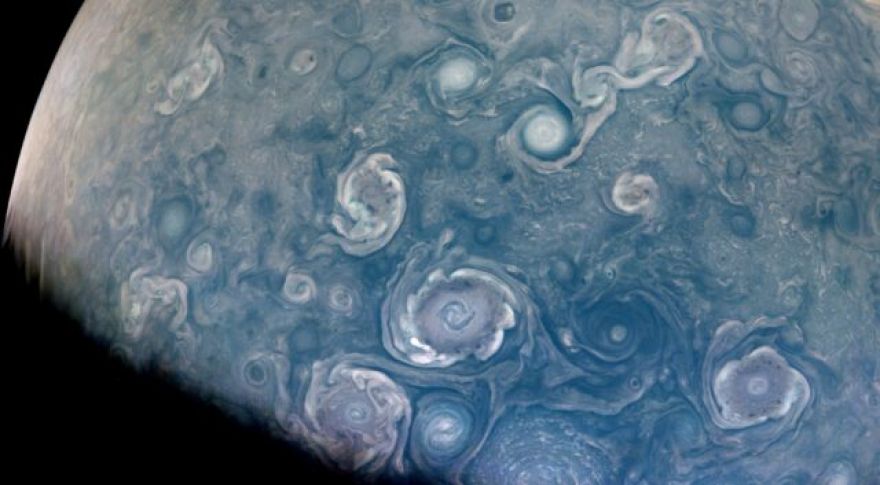
NASA Wants YOU to Help Spot These Mesmerizing Vortices on Jupiter
Analysis of a set of July photos from NASA’s JunoCam has revealed a cluster of swirling storms near Jupiter’s north pole. The agency released the entire dataset, which is cool enough all on its own. But now, a NASA citizen science project called “Jovian Vortex Hunter” is seeking volunteers to “spot and help categorize vortices and other atmospheric phenomena visible in JunoCam photos of Jupiter.” That’s right: NASA wants YOU to help spot these swirling vortices on Jupiter.
Volunteers don’t need any training or any special hardware or software. Anyone, anywhere, can participate with a cellphone or laptop. What you’re looking for is storms like these:
These are some examples of the vortices that volunteers are helping to spot. Brown clouds are ammonia or ammonium hydrosulfide. White clouds are water vapor. Image: NASA / Junocam, via Zooniverse
These powerful storms can be over 30 miles (50 kilometers) in height and hundreds of miles across. The largest one — in fact, the largest storm in the entire solar system — is Jupiter’s Great Red Spot, which is ten thousand miles from side to side. It could swallow the Earth with no trouble. Figuring out how these storms develop is key to understanding Jupiter’s atmosphere, as well as the fluid dynamics and cloud chemistry that create the planet’s other atmospheric features.
NASA scientists are particularly interested in the vortices’ varying . For example, cyclones, which spin counter-clockwise in the northern hemisphere and clockwise in the southern, and anti-cyclones, which rotate clockwise in the northern hemisphere and counter-clockwise in the southern hemisphere, exhibit very different colors and shapes.
Music of the Spheres
Gigantic, stable, long-lived storms are a recurring theme on Jupiter. But with Juno, we can look through the tops of the clouds. Jupiter is mostly hydrogen by mass, and it has no true surface. If you fell from space onto Jupiter, there’s no surface to land on. Instead, we think it makes a gradual transition through thicker and denser clouds into an opaque, ammoniac slush with perhaps the density of water. At a thousand kilometers below the cloud-tops, it’s so cold that the distinction between liquid and gas begins to blur. Hydrogen becomes a supercritical fluid, free of surface tension and capable of wafting through solids like a gas instead of seeping like a liquid. But there’s nothing solid on Jupiter.
Wind belts carve unobstructed paths through the gas giant’s atmosphere. These stable circulations produce resident storms that dance around the planet’s poles with geometric precision. In 2021, Jupiter had storms in a perfect octagon at the north pole and a perfect hexagon at the south. Before that, the gas giant’s south pole had five storms arranged around a central maelstrom, itself the size of the United States.
This 2021 JunoCam snap shows the octagonal array of storms at Jupiter’s north pole.
But the Jovian spirals are just one of the places we can find geometric shapes on gas giants in our solar system. Scientists are working to explain why storms on Jupiter form these whorls and vortices, instead of behaving like Saturn. Saturn, too, has a vortex at its north pole that dances to the music of the spheres. But currently, it forms a precise hexagon:
Saturn’s hexagon, as it would appear to the human eye. Image: NASA/JPL
Mathematical studies show that these polar vortices can form stable regular polygons with anywhere from three to eight sides. But the jury’s still out on why Jupiter’s polar storms don’t look like Saturn’s. Projects like this help scientists to explain why storms on these gas giants behave as they do.
NASA Citizen Science Projects
Participating in NASA’s citizen science efforts can open up an entirely new universe of Cool Space Stuff. And just a little bit of digging around on their citizen-science website revealed a whole host of planetary science projects suitable for kids K-12. Right now, they’ve got a little bit of everything. In addition to this Jupiter project, NASA has a project called , where participants study photographs of the Earth to pick out geographical features such as volcanoes, glaciers, cities, and islands. And while it’s geared for family and kids K-12, anyone can .
You can find more information about NASA citizen science at and .